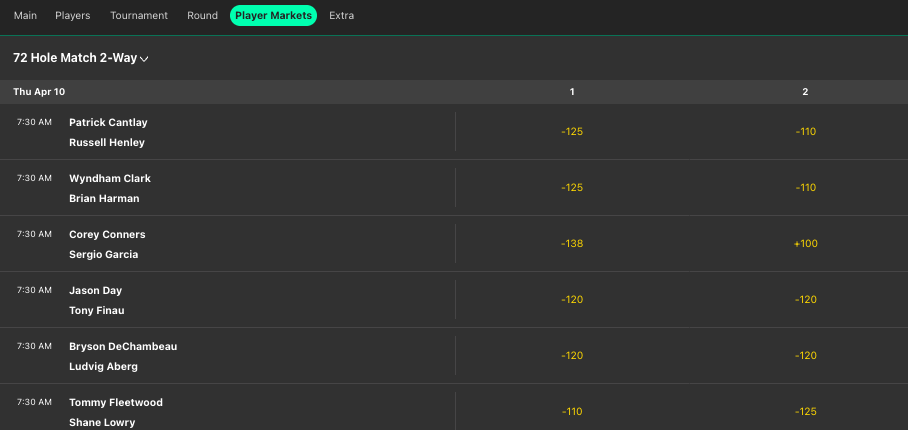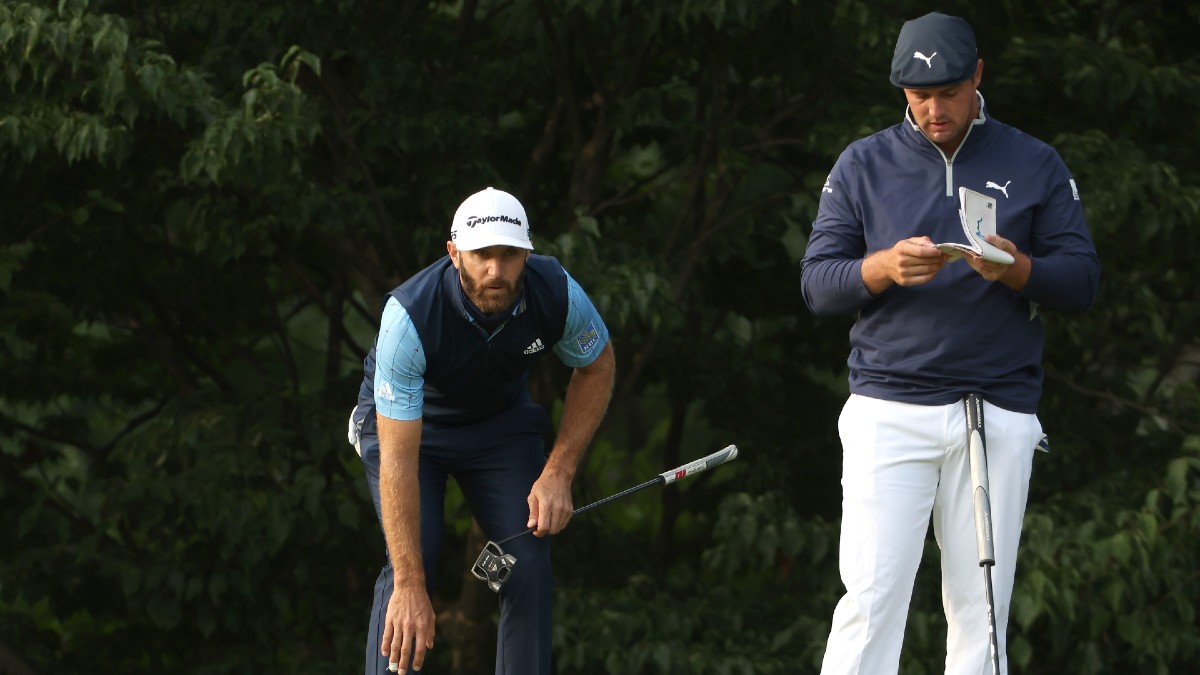Golf matchup betting might not offer the same “turn $5 into $1,000” rush like picking the outright winner or first-round leader, but matchups are among the most popular markets in the sport.
There are several different kinds of matchup bets to explore — 2-ball, 3-ball and group betting being the most popular. These types of wagers are most commonly for a single round or for the entire tournament. And now, sportsbooks even offer matchup betting for a single hole.
Below we’ll cover how these wagers work, and how ties work, which is particularly relevant in golf betting.
_InlineAdBlock=2
2-Ball Matchups
Two-ball matchups feature two players going head-to-head. You’re just trying to pick which golfer will score better.
Here’s how it will look at bet365:
Full Tournament (or 72-Hole) Matchups

Round (or 18-Hole) Matchups
Round matchups, often called 18-hole matchups, work the same way, with the odds adjusted to account for the fact that it’s easier for a lesser player to beat a better player over 18 holes instead of 72.
Sportsbooks will offer Round 1 matchups in the days leading up to the event, and new pairings between each round over the weekend. On Saturday and Sunday, the matchups offered will usually be between players paired together, or close in tee times, so that factors like weather and course conditions can’t affect things.
What If One Golfer Misses the Cut?
You’ll win your full-tournament matchup bet if your golfer makes the cut and the other one doesn’t — even if your golfer implodes on the weekend and ends up with a worse score to par at the end of the tournament.
If both players miss the cut, the winner will be whoever had the better score after those two rounds. If a player withdraws during the tournament, you’ll lose the matchups if you bet on them.
Tie Option vs. No Tie Option
Depending on the sportsbook, you may see slightly different 2-player matchups listed that can actually make a big impact.
Generally, you want to bet the option where a tie results in refunded bets and not the one where the tie is its own bet. That’s because the three-way option has more vig, which is advantageous for the sportsbook.
BetMGM lists two players with a tie bet available and two players with a tie resulting in a refund right next to each other. Here’s another 2025 Masters example.
| Golfer | Odds | Probability |
|---|---|---|
| Scheffler | -105 | 51.22% |
| McIlroy | -105 | 51.22% |
| Tie | +1600 | 5.88% |
- For the two-way market where the tie is refunded, the sportsbook margin is 4.71%.
- The margin on this three-way market with the tie is about 8% — that means for every dollar wagered, the sportsbook will keep on average 8 cents.
If you don’t think the tie will come into play and want to bet your golfer at a slightly better price, go ahead. Just know that in the long run, it’s disadvantageous because the sportsbook margin is higher.
DataGolf’s simulations say Rory and Scheffler will tie at the Masters in a single round about 10% of the time, but you’re only getting +750 for those ties usually instead of +1000. In a full tournament matchup, you’d expect a tie just under 5% of the time — but you’re getting +1600, not +2500.
3-Ball Matchups
Three-ball matchups feature three players, with each usually at plus-money. That’s because it’s harder to beat two other players than one, so the probabilities are spread out across the three players.
Sportsbooks use the actual tournament threesome pairings so that they can’t get burned by the variables that come with different tee times, like weather or the course softening up later in the day.
Let’s use a Round 1 3-ball example from the British Open.
Koepka was the clear favorite among his group for a Round 1 3-ball matchup on Thursday.
But the sportsbook margin is also high on these bets at 11%, even though everyone is plus-money. Much higher than the two-way matchup.
| Golfer | Odds | Probability |
|---|---|---|
| Brooks Koepka | +100 | 50% |
| Jason Kokrak | +175 | 36.36% |
| Garrick Higgo | +300 | 25% |
If two (or all three) players tie, dead heat rules will apply at most sportsbooks, meaning your winnings will be cut by the number of players who tied.
3-Ball Dead Heat Rules
The payouts for a 3-ball tie can be a bit confusing. If your player ties with one other player, you lose half your bet amount, and the other half of your bet wins at the original odds. Here’s an example:
- You bet $10 on Garrick Higgo +300 and he ties with Koepka and beats Kokrak.
- Since he tied, $5 of your bet loses.
- The other $5 is paid out at +300, meaning you win $15.
- So off a $10 total wager, you got $15 back, good for $5 in profit.
There is an important distinction between the stake being split and the odds being split. If you’re betting something at plus-money, it will look at the same. But if you’re betting a player in a 3-ball at -150, it may seem a bit different.
Here’s an example betting a player at -150, where you’d actually lose money if your player ties.
- Say you bet $15 on Scottie Scheffler at -150, and he ties with Rory McIlroy. A win would have paid $10.
- You lose half your stake at $7.50, and the other $7.50 stands.
- That means you’re betting $7.50 at -150, which results in $5 profit (you can use our bet calculator to figure that out.)
| Bet | Wager | Total Return |
|---|---|---|
| First Half of Wager (L) | $7.50 | $0 |
| Second Half of Wager (W) | $7.50 | $12.50 |
| Total | $15 | -$2.50 |
Group Betting
There’s a third type of matchup betting that features about five players who have roughly the same odds to win the tournament. It’s often called “group betting.”
The golfer with the best score out of these five will win the group. But the hold is even higher than 3-ball betting — this group at bet365 has a 14.3% sportsbook margin.
Dead heat rules will also apply here, so if two players tie for the best score, your bet will be cut in half.
| Golfer | Odds | Probability |
|---|---|---|
| Jon Rahm | +163 | 33.24% |
| Brooks Koepka | +400 | 17.48% |
| Xander Schauffele | +400 | 17.48% |
| Justin Thomas | +450 | 15.9% |
| Jordan Spieth | +450 | 15.9% |
